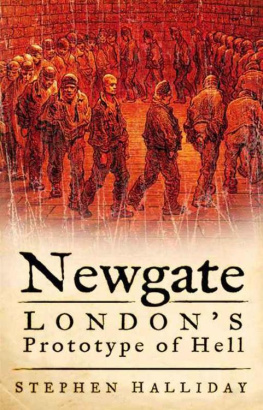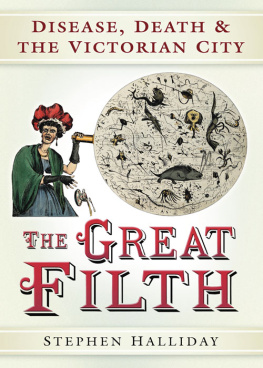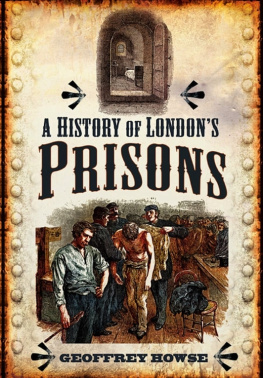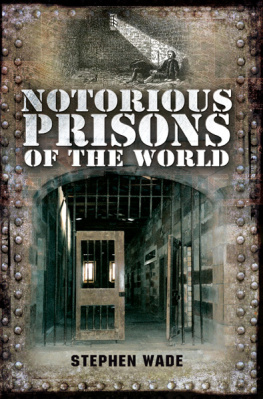
Newgate
Newgate
L ONDONS
Prototype of Hell
S TEPHEN H ALLIDAY

First published in the United Kingdom in 2006 by Sutton Publishing Limited
This paperback edition first published in 2007 by Sutton Publishing Limited
Reprinted in 2009 by
The History Press
The Mill, Brimscombe Port
Stroud, Gloucestershire, GL5 2QG
www.thehistorypress.co.uk
This ebook edition first published in 2013
All rights reserved
Stephen Halliday, 2006, 2007, 2013
The right of Stephen Halliday to be identified as the Author of this work has been asserted in accordance with the Copyrights, Designs and Patents Act 1988.
This ebook is copyright material and must not be copied, reproduced, transferred, distributed, leased, licensed or publicly performed or used in any way except as specifically permitted in writing by the publishers, as allowed under the terms and conditions under which it was purchased or as strictly permitted by applicable copyright law. Any unauthorised distribution or use of this text may be a direct infringement of the authors and publishers rights, and those responsible may be liable in law accordingly.
EPUB ISBN 978 0 7524 9555 2
Original typesetting by The History Press
Prototype of hell
is a quotation from
Henry Fielding,
novelist, playwright
and magistrate
Contents
PREFACE
Newgate in the English Penal System
That horrid place an emblem of hell itself
N ewgate occupies a unique place in the history of the English penal system, though the gaol itself has not existed for over a century, having been demolished in 1902. Its reputation was such that in the eighteenth century Daniel Defoe, who had himself been a prisoner in Newgate, described it in his novel Moll Flanders as that horrid place an emblem of hell itself. His fellow writer, Henry Fielding, whose work as a magistrate required him to visit Newgate, described it as one of the dearest places on earth on account of the cruel exactions the gaolers imposed upon the inmates. It has given its name to a phrase which has entered the language as a simile for blackness and filth, as black as Newgates knocker. Such is its reputation abroad that New York adopted the name Newgate for one of its early gaols, Sing Sing later replacing it.
The name itself is a misnomer, arising from a mistaken belief that the Medieval gatehouse which served as the first gaol in the reign of Henry II was a later addition to the four Roman gates to the City of London. In the early years of the twentieth century excavation of the site revealed that Newgate was itself of Roman origin. There have been five gaols at Newgate. The original gatehouse was substantially reconstructed in the early fifteenth century through a bequest in the will of Richard Whittington, four times Mayor of London, who had been appalled by the filth and disease that beset Newgate during his last period as mayor. This building survived until the Great Fire of 1666, which destroyed most of Whittingtons gaol, including the statue of Whittington himself accompanied by a cat. Its successor, the third Newgate, fell into disrepair and was in the process of reconstruction when the Gordon Riots of 1780 destroyed it and much else besides. The fifth and final Newgate was completed to the designs of George Dance the Younger and opened in 1785.
Newgate owes much of its notoriety to its association with executions. In the sixteenth century its proximity to Smithfield made it a convenient place in which to hold Dissenters who were to be burned at the stake to satisfy the religious whims of Tudor monarchs. In the seventeenth and eighteenth centuries Newgate served as the embarkation point for those who were to be hanged (or worse) at Tyburn, near the present site of Marble Arch. The execution developed into a macabre ritual, preceded by the condemned sermon preached in the prison chapel itself by the prison chaplain or Ordinary who would then write up an account, preferably containing a last-minute confession on the scaffold. These accounts became a recognised literary genre, the Newgate Calendar , to be sold to the crowds who habitually gathered along the route to Tyburn or, if they were able to afford a seat, at Tyburn itself. Executions became a gruesome form of public entertainment, accompanied by drunkenness, violence, attempted rescues and the occasional riot. James Boswell, a man not usually noted for his sensitivity, found himself unable to sleep after attending a Tyburn execution. The Tyburn rituals and other events associated with Newgate were celebrated by artists such as William Hogarth and James Gillray. In 1783 executions were transferred to Newgate itself, a scaffold being erected outside the gaols debtors door, so the building itself became the focus of the mayhem associated with public executions until they were moved inside the gaol in 1868, the last execution occurring at Newgate in May 1902.
Charles Dickens and William Thackeray were among those who attended the Newgate drop on execution days and wrote about it. To theirs may be added many other names which became associated with Newgate and its victims. Bulwer Lytton, author of The Last Days of Pompeii , helped to found that distinctive literary form, the Newgate Novel. The name of the incompetent, bungling axeman Jack Ketch became synonymous with that of a brutal executioner and he also gave his name to Jack Ketchs Kitchen, within the gaol itself, where cadavers were boiled and dismembered. The notorious perjurer Titus Oates sent many to their deaths at Newgate before himself being incarcerated there. The Italian libertine Casanova passed through the gaol while the Cato Street conspirators were beheaded there (after first being hanged) in 1820. Jack Sheppard was hanged at Tyburn, having in the meantime become a popular hero for his many audacious escapes from Newgate. He was quickly followed on the scaffold by his accuser, Jonathan Wild, the eighteenth-century criminal and supergrass whose exploits were soon celebrated in John Gays The Beggars Opera and, in the twentieth century, by Bertold Brechts The Threepenny Opera . The Newgate Monster, who quite possibly did not exist except in the imaginations of his victims, spent six years in Newgate in the 1790s for sticking sharp implements into ladies bottoms. A gentler association is with the memory of Elizabeth Fry, who began the process of making Newgate a more wholesome place in the nineteenth century.
Newgate prisons reputation is thus perpetuated not only in the phrase that it has given to the English language, but in the events and the people associated with it. It was eventually demolished to make way for another building on the corner of Newgate Street, which has similar associations with foul deeds and their consequences: the Central Criminal Court, better known as the Old Bailey. This volume records the history of one of Londons most notorious buildings, which served the capital for more than 700 years, from the reign of Henry II to that of Edward VII.
Stephen Halliday
June 2007
A hell such as Dante might have conceived.
Giacomo Casanova
An emblem of hell itself.
Daniel Defoe, Moll Flanders
ONE
The Heinous Gaol of Newgate
By reason of the foetid and corrupt atmosphere that is in the heinous gaol of Newgate many persons are now dead who would be alive.
(Proclamation of Richard Whittington, Mayor of London, 1419)
A merciless race of men and, by being conversant with scenes of misery, steeled against any tender sensation.
(William Blackstones description of the qualities of a gaoler, c . 1770)
Next page
















